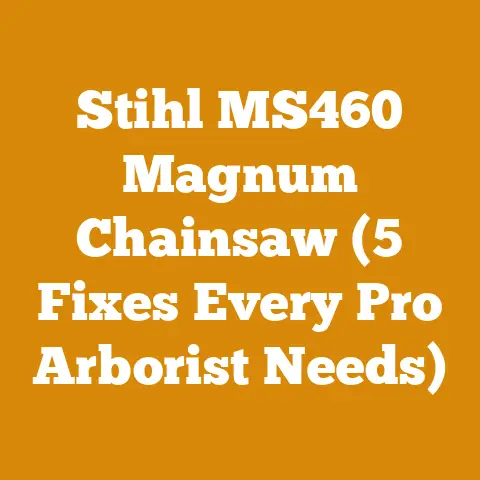Wood Burning Stove Multi Fuel: Performance vs Wood Only (Key Insights)
Did you know that the choice between a multi-fuel and a wood-only burning stove could dramatically affect not just your heating bill, but also your environmental footprint? It’s a decision that many homeowners grapple with, and understanding the nuances is key to making an informed choice. Let’s dive into the world of wood burning stoves and explore the performance differences between multi-fuel and wood-only models.
Multi-Fuel vs. Wood-Only Stoves: Unveiling the Key Differences
When I first started working with wood stoves, I was amazed by the variety available. Multi-fuel stoves and wood-only stoves are two popular options, each with its own set of advantages and disadvantages. Understanding these differences is crucial for selecting the right stove for your needs.
What is a Wood-Only Stove?
A wood-only stove is designed specifically to burn wood. These stoves are optimized for the combustion characteristics of wood, typically featuring a larger firebox and an air supply system tailored for efficient wood burning.
What is a Multi-Fuel Stove?
A multi-fuel stove, on the other hand, is designed to burn a variety of fuels, including wood, coal, and smokeless fuels. These stoves often have a grate for burning coal and a different air supply system to accommodate the different combustion properties of various fuels.
Performance Comparison: A Detailed Look
The performance of a wood burning stove is determined by several factors, including heat output, efficiency, and emissions. Let’s compare multi-fuel and wood-only stoves in each of these areas.
Heat Output: BTU and Heating Capacity
Heat output is measured in British Thermal Units (BTU). This measures the amount of heat the stove can produce in an hour. The heating capacity refers to the size of the space the stove can effectively heat.
-
Wood-Only Stoves: Generally, wood-only stoves are designed to provide a steady and consistent heat output when burning wood. The BTU output is directly related to the type and amount of wood burned.
-
Multi-Fuel Stoves: Multi-fuel stoves can achieve higher BTU outputs when burning coal or smokeless fuels compared to wood. This can be advantageous for heating larger spaces or during extremely cold weather.
My Experience: I once installed a multi-fuel stove in a large, drafty farmhouse. The owner appreciated the option to burn coal during the coldest months to keep the house warm. However, they preferred wood for everyday heating due to its lower cost and environmental impact.
Efficiency: Maximizing Heat from Fuel
Efficiency refers to how effectively the stove converts fuel into usable heat. Higher efficiency means less fuel is needed to achieve the same level of warmth.
-
Wood-Only Stoves: Modern wood-only stoves often have high efficiency ratings, thanks to advanced combustion technologies like secondary combustion and catalytic converters. These features help to burn off gases and particles that would otherwise be released as emissions. I’ve seen some models reach efficiencies of over 80%.
-
Multi-Fuel Stoves: The efficiency of multi-fuel stoves can vary depending on the fuel being burned. While they can be efficient when burning coal or smokeless fuels, their efficiency may be lower when burning wood compared to a dedicated wood-only stove. This is because the air supply system is designed to accommodate a wider range of fuels, which may not be optimal for wood combustion.
Data Point: According to the EPA, certified wood stoves must meet certain efficiency standards to reduce emissions. Multi-fuel stoves also need to meet these standards, but their wood-burning efficiency may still be lower than that of a wood-only stove.
Emissions: Environmental Impact
Emissions from wood burning stoves are a significant concern, as they can contribute to air pollution. The type of stove and the fuel burned both play a role in the level of emissions produced.
-
Wood-Only Stoves: Modern, EPA-certified wood-only stoves are designed to minimize emissions. These stoves use advanced combustion technologies to burn wood more completely, reducing the amount of smoke and particulate matter released into the atmosphere.
-
Multi-Fuel Stoves: Multi-fuel stoves can produce higher emissions when burning wood compared to wood-only stoves. This is because the air supply system is not optimized for wood combustion, leading to less complete burning and more smoke. However, when burning coal or smokeless fuels, multi-fuel stoves can produce lower emissions compared to older, non-certified wood stoves.
Case Study: A study conducted by the University of California, Berkeley, found that replacing older, non-certified wood stoves with EPA-certified models significantly reduced particulate matter emissions in residential areas.
Fuel Versatility: The Multi-Fuel Advantage
One of the main advantages of multi-fuel stoves is their ability to burn a variety of fuels. This can be particularly useful in areas where wood is scarce or expensive.
Types of Fuels for Multi-Fuel Stoves
- Wood: Both hardwood and softwood can be burned in multi-fuel stoves, although hardwood generally provides more heat and burns longer.
- Coal: Anthracite coal is a popular choice for multi-fuel stoves due to its high heat output and low smoke production.
- Smokeless Fuels: These are manufactured fuels designed to burn cleanly and efficiently. They are often made from compressed coal dust or other materials.
Fuel Considerations
- Cost: The cost of different fuels can vary significantly depending on location and availability. Wood is often the most affordable option, but coal and smokeless fuels may be more cost-effective in some areas.
- Availability: The availability of different fuels can also vary. In some areas, wood may be readily available, while coal or smokeless fuels may be harder to find.
- Environmental Impact: The environmental impact of different fuels should also be considered. Wood is a renewable resource, but burning it can produce emissions. Coal is a fossil fuel and produces more emissions than wood. Smokeless fuels are designed to burn more cleanly, but their production can still have environmental impacts.
My Tip: Before choosing a multi-fuel stove, research the availability and cost of different fuels in your area. Consider the environmental impact of each fuel and choose the one that best meets your needs.
Stove Design and Features: What to Look For
The design and features of a wood burning stove can significantly impact its performance and ease of use. When choosing a stove, consider the following factors:
Firebox Size and Design
The firebox is the area where the fuel is burned. The size and design of the firebox can affect the amount of fuel the stove can hold and how efficiently it burns.
-
Wood-Only Stoves: Wood-only stoves typically have larger fireboxes designed to accommodate longer pieces of wood. The design of the firebox is optimized for wood combustion, with air inlets strategically placed to promote efficient burning.
-
Multi-Fuel Stoves: Multi-fuel stoves often have smaller fireboxes with a grate for burning coal. The air supply system is designed to provide air to both the top and bottom of the fire, which is necessary for burning coal effectively.
Air Supply System
The air supply system controls the amount of air that enters the firebox. This is crucial for controlling the combustion process and maximizing efficiency.
-
Wood-Only Stoves: Wood-only stoves typically have a primary air inlet for starting the fire and a secondary air inlet for burning off gases and particles. Some models also have a tertiary air inlet for even more complete combustion.
-
Multi-Fuel Stoves: Multi-fuel stoves have a more complex air supply system to accommodate the different combustion properties of various fuels. They often have separate air inlets for wood and coal, as well as adjustable dampers to control the airflow.
Catalytic vs. Non-Catalytic Stoves
Catalytic and non-catalytic stoves are two types of wood burning stoves that use different methods to reduce emissions.
-
Catalytic Stoves: Catalytic stoves use a catalytic converter to burn off gases and particles. The catalytic converter is a ceramic honeycomb coated with a catalyst, such as platinum or palladium. When exhaust gases pass through the converter, the catalyst helps to oxidize them, reducing emissions.
-
Non-Catalytic Stoves: Non-catalytic stoves use a combination of advanced combustion technologies, such as secondary combustion and air injection, to reduce emissions. These stoves are generally less expensive than catalytic stoves, but they may not be as efficient.
My Recommendation: If you are concerned about emissions, consider a catalytic stove. These stoves are more expensive, but they can significantly reduce the amount of smoke and particulate matter released into the atmosphere.
Installation and Maintenance: Ensuring Safe and Efficient Operation
Proper installation and maintenance are essential for ensuring the safe and efficient operation of your wood burning stove.
Installation Requirements
- Clearance to Combustibles: Wood burning stoves must be installed with adequate clearance to combustible materials, such as walls, ceilings, and furniture. The exact clearance requirements will vary depending on the stove model and local building codes.
- Chimney: A properly sized and installed chimney is essential for venting exhaust gases safely. The chimney must be made of heat-resistant materials and must be inspected regularly for damage.
- Hearth Pad: A non-combustible hearth pad must be installed under the stove to protect the floor from heat and embers.
Maintenance Tips
- Regular Cleaning: Clean the stove and chimney regularly to remove creosote buildup. Creosote is a flammable substance that can accumulate in the chimney and cause a chimney fire.
- Ash Removal: Remove ashes from the firebox regularly to maintain efficient burning.
- Inspection: Inspect the stove and chimney regularly for damage. Replace any damaged parts promptly.
My Safety Tip: Always follow the manufacturer’s instructions for installation and maintenance. If you are not comfortable performing these tasks yourself, hire a qualified professional.
Cost Analysis: Initial Investment and Long-Term Expenses
The cost of a wood burning stove includes the initial purchase price, installation costs, and ongoing expenses such as fuel and maintenance.
Initial Investment
- Stove Price: The price of a wood burning stove can range from a few hundred dollars to several thousand dollars, depending on the model, features, and brand.
- Installation Costs: Installation costs can vary depending on the complexity of the installation and local labor rates. These costs may include the cost of a chimney, hearth pad, and professional installation services.
Long-Term Expenses
- Fuel Costs: Fuel costs will vary depending on the type of fuel used and local prices. Wood is often the most affordable option, but coal and smokeless fuels may be more cost-effective in some areas.
- Maintenance Costs: Maintenance costs include the cost of cleaning supplies, replacement parts, and professional services such as chimney cleaning.
My Budgeting Tip: Before purchasing a wood burning stove, create a budget that includes both the initial investment and long-term expenses. This will help you to choose a stove that fits your needs and budget.
Environmental Considerations: Making a Sustainable Choice
Wood burning stoves can have both positive and negative environmental impacts. When choosing a stove, consider the following factors:
Renewable Resource
Wood is a renewable resource, but it must be harvested sustainably to avoid deforestation and other environmental problems.
Emissions
Wood burning stoves can produce emissions that contribute to air pollution. Choose an EPA-certified stove to minimize emissions.
Carbon Neutrality
Wood burning is often considered carbon neutral because the carbon dioxide released during combustion is offset by the carbon dioxide absorbed by trees during their growth. However, this is only true if the wood is harvested sustainably and burned efficiently.
My Sustainability Tip: Choose an EPA-certified stove and burn sustainably harvested wood to minimize your environmental impact.
Choosing the Right Stove: Key Considerations
Selecting the right wood burning stove involves careful consideration of your heating needs, budget, and environmental concerns.
Assess Your Heating Needs
- Room Size: Determine the size of the space you need to heat. This will help you to choose a stove with the appropriate BTU output.
- Climate: Consider the climate in your area. If you live in a cold climate, you will need a stove with a higher BTU output.
- Insulation: Assess the insulation in your home. A well-insulated home will require less heat than a poorly insulated home.
Set a Budget
- Initial Investment: Determine how much you are willing to spend on the stove and installation.
- Long-Term Expenses: Estimate your ongoing fuel and maintenance costs.
Consider Environmental Factors
- Emissions: Choose an EPA-certified stove to minimize emissions.
- Fuel Source: Consider the sustainability of your fuel source.
My Final Thought: Take your time and do your research before choosing a wood burning stove. Consider all of the factors discussed in this guide to make an informed decision.
Wood Selection and Preparation: Maximizing Efficiency
The type of wood you burn and how you prepare it can significantly impact the performance of your wood burning stove.
Types of Wood
- Hardwood: Hardwoods, such as oak, maple, and birch, are denser than softwoods and provide more heat per unit volume. They also burn longer and produce less smoke.
- Softwood: Softwoods, such as pine, fir, and spruce, are less dense than hardwoods and provide less heat per unit volume. They also burn faster and produce more smoke.
Seasoning Wood
Seasoning wood involves drying it to reduce its moisture content. Properly seasoned wood burns more efficiently and produces less smoke.
- Moisture Content: Aim for a moisture content of 20% or less.
- Drying Time: Season wood for at least six months, or longer in humid climates.
Wood Storage
Store seasoned wood in a dry, well-ventilated area to prevent it from reabsorbing moisture.
My Wood Prep Tip: Invest in a moisture meter to accurately measure the moisture content of your wood. This will help you to ensure that you are burning properly seasoned wood. I have found that a consistent wood source is worth the investment.
Safety Measures: Protecting Your Home and Family
Safety should always be a top priority when operating a wood burning stove.
Carbon Monoxide Detectors
Install carbon monoxide detectors in your home to alert you to the presence of this deadly gas.
Smoke Detectors
Install smoke detectors in your home to alert you to the presence of smoke.
Fire Extinguisher
Keep a fire extinguisher nearby in case of a fire.
Chimney Fires
Learn how to respond to a chimney fire.
My Safety Checklist: Before lighting your wood burning stove, always check that your carbon monoxide and smoke detectors are working properly. I also recommend having your chimney professionally inspected annually.
Troubleshooting Common Issues: Keeping Your Stove Running Smoothly
Even with proper installation and maintenance, you may encounter some common issues with your wood burning stove.
Poor Draft
A poor draft can cause smoke to back up into your home.
- Causes: Blocked chimney, cold chimney, insufficient air supply.
- Solutions: Clean the chimney, warm the chimney with a torch, open a window to increase air supply.
Excessive Smoke
Excessive smoke can be caused by burning unseasoned wood or by a poor draft.
- Causes: Unseasoned wood, poor draft, dirty stove.
- Solutions: Burn seasoned wood, improve draft, clean the stove.
Creosote Buildup
Creosote buildup can increase the risk of a chimney fire.
- Causes: Burning unseasoned wood, poor draft, low stove temperature.
- Solutions: Burn seasoned wood, improve draft, operate the stove at a higher temperature, clean the chimney regularly.
My Troubleshooting Tip: Keep a log of any issues you encounter with your wood burning stove. This will help you to identify patterns and troubleshoot problems more effectively.
Advanced Techniques: Optimizing Wood Burning Efficiency
For those looking to take their wood burning skills to the next level, here are some advanced techniques for optimizing efficiency.
Top-Down Burning
Top-down burning involves loading the firebox with wood from top to bottom and lighting the fire at the top. This method can improve efficiency and reduce emissions.
Batch Burning
Batch burning involves loading the firebox with a large amount of wood and letting it burn down completely before reloading. This method can provide a more consistent heat output.
Using a Thermal Mass
A thermal mass, such as a stone wall or a water tank, can absorb heat from the stove and release it slowly over time. This can help to maintain a more consistent temperature in your home.
My Experiment: I once experimented with using a water tank as a thermal mass. I found that it helped to keep my home warm for longer periods of time, especially during the night.
The Future of Wood Burning Stoves: Innovations and Trends
The wood burning stove industry is constantly evolving, with new innovations and trends emerging all the time.
Smart Stoves
Smart stoves use sensors and electronic controls to optimize combustion and reduce emissions.
Pellet Stoves
Pellet stoves burn wood pellets, which are a renewable and sustainable fuel source.
Gasification Stoves
Gasification stoves use a two-stage combustion process to burn wood more efficiently and reduce emissions.
My Prediction: I believe that smart stoves and gasification stoves will become increasingly popular in the future as people look for more efficient and environmentally friendly ways to heat their homes.
Multi-Fuel vs. Wood-Only: A Summary Table
To help you quickly compare the key differences between multi-fuel and wood-only stoves, here’s a summary table:
| Feature | Wood-Only Stove | Multi-Fuel Stove |
|---|---|---|
| Fuel | Wood | Wood, Coal, Smokeless Fuels |
| Efficiency | Generally higher when burning wood | Varies depending on fuel; may be lower with wood |
| Emissions | Generally lower when burning wood | Can be higher when burning wood |
| Heat Output | Steady and consistent when burning wood | Can achieve higher BTU with coal/smokeless fuels |
| Firebox Design | Larger, optimized for wood combustion | Smaller, with grate for coal burning |
| Air Supply | Optimized for wood combustion | More complex, adjustable for different fuels |
| Cost | Varies depending on model and features | Varies depending on model and features |
| Maintenance | Regular cleaning and inspection | Regular cleaning and inspection |
Personal Anecdotes and Insights
Throughout my years of experience with wood burning stoves, I’ve learned a few valuable lessons that I’d like to share with you.
- The Importance of Seasoning: I once made the mistake of burning unseasoned wood in my stove. The result was a smoky, inefficient fire that produced a lot of creosote. I learned my lesson and now I always make sure to burn properly seasoned wood.
- The Value of Professional Installation: I’ve seen many DIY stove installations that were not done properly. This can be dangerous and can void the warranty on your stove. I always recommend hiring a qualified professional to install your stove.
- The Joy of a Warm Home: There’s nothing quite like the feeling of a warm home on a cold winter day. A wood burning stove can provide that warmth and comfort, while also saving you money on your heating bill.
Conclusion: Making the Right Choice for Your Home
Choosing between a multi-fuel and a wood-only stove is a personal decision that depends on your individual needs and preferences. Consider your heating needs, budget, environmental concerns, and the availability of different fuels in your area. By carefully weighing these factors, you can choose the stove that is right for your home. Remember, safety and proper maintenance are paramount to enjoying the warmth and efficiency of your wood burning stove for years to come.
I hope this guide has been helpful in your journey to selecting the perfect wood burning stove. Happy heating!






